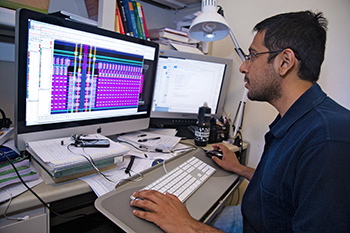Daily Business Report-Sept. 24, 2013
Demand for Rental Housing on the Upswing
Forecast predicts two more years of rent increases
Two more years of rent increases have been forecast for the four Southern California apartment markets — San Diego, Los Angeles and Orange counties and the Inland Empire — as the rental housing market continues to absorb units faster than it completes them. That’s the conclusion of the 2013 USC Casen Multifamily Forecast issued on Monday. Between the second quarters of 2012 and 2013, the four markets completed almost 6,700 new units, a three-year high. However, it absorbed nearly 11,900 units during the same period.
In the second quarter of this year, San Diego County had the lowest vacancy rate at 2.3 percent, a 37.1 percent decrease from the previous year. It was followed by Los Angeles County at 3.2 percent vacancy (down 10.6 percent), Orange County at 3.2 percent (down 12.4 percent), and the Inland Empire at 3.6 percent (down 17.3 percent).
While average rents increased in all four markets, Los Angeles County, where renters pay an average of $1,435, had the largest rate of increase at 2.86 percent. The area’s most expensive rental market, Orange County, increased 2.8 percent to $1,572. San Diego County rents increased 2.75 percent to $1,388, while the Inland Empire increased 1.9 percent to $1,059, according to the report.
“Despite marked improvements in employment and the overall economy, the rapid increase in home prices and interest rates are pricing first-time homebuyers out of the local market,” said Richard Green, director of the USC Lusk Center for Real Estate. “As more and more of these households become renters instead of buyers, we will continue to see fewer vacancies and higher rents.”
The El Cajon, Santee, Lakeside submarket had the lowest vacancy rate with 1 percent, while Victorville had the highest vacancy rate at 7.8 percent.
The submarket with the lowest rent was Victorville at $755, while Santa Monica had the highest at $2,328.
How Much to Fix Backlog of City Infrastructure Projects?
Nobody Knows
The oft-used value of $898 million attached to the backlog of San Diego’s infrastructure projects is obsolete and probably seriously understated, according to a new report presented to the City Council Monday by the city’s independent budget analyst, City News Service reports. The figure is based on old information and there hasn’t been enough recent data to put a cost on maintenance to the city’s 1,600 or so facilities, which include roads, sidewalks, buildings, parks and the like, the report says. At a news conference, Councilman Mark Kersey said, “We have no idea” how big the backlog really is because the city is only now embarking on condition assessments, which will take about one year to complete. “We really need to admit the problem is larger than what we’ve talked about in the past,” said Kersey, who chairs the council’s Infrastructure Committee.
Poll Shows Fletcher With Early Lead
Qualcomm executive Nathan Fletcher is leading the race for San Diego mayor with an 8-point edge over City Councilman Kevin Faulconer and a 13-point margin over Councilman David Alvarez, according to a U-T San Diego/10News Poll. The survey released Monday night showed Fletcher at 30 percent when respondents were asked who they would vote for if the election were conducted today, the U-T San Diego reports.

Northrop Grumman Readies MQ-8C Fire Scout for Flight Operations
Northrop Grumman Corp. turned on the power to the U.S. Navy’s first MQ-8C Fire Scout unmanned helicopter and rotated the aircraft’s four blades for the first time during initial ground testing and engine runs Friday at Naval Base Ventura County Point Mugu, Calif. Conducting initial engine runs of the aircraft allows engineers to collect data to ensure that all the aircraft’s systems are functioning and communicating properly prior to its first flight. “Completion of these tests signifies our steady progress toward the first flight of the MQ-8C Fire Scout,” said George Vardoulakis, vice president of medium range tactical systems at Northrop Grumman. “We continue to work closely with our Navy customer, ensuring that the Fire Scout system is checked out and ready before operational use.”
This latest aircraft upgrade to the Fire Scout system provides the Navy with more than twice the endurance and three times the payload carrying capacity. Northrop Grumman is the Navy’s prime contractor for the Fire Scout program and is currently under contract to produce MQ-8C aircraft for deployment beginning in 2014.

Bioengineers Research Smart Cameras and
Senors That Mimic or Exceed Human Capability
UC San Diego bioengineering professor Gert Cauwenberghs has been selected by the National Science Foundation to take part in a five-year, $10 million research project to develop a computer vision system that will approach or exceed the capabilities and efficiencies of human vision. The Visual Cortex on Silicon project, funded through NSF’s Expeditions in Computing program, aims to create computers that not only record images but also understand visual content and situational context in the way humans do, at up to a thousand times the efficiency of current technologies, according to an NSF announcement. Smart machine vision systems that understand and interact with their environments could have a profound impact on society, including aids for visually impaired persons, driver assistance capabilities for reducing automotive accidents, and augmented reality systems for enhanced shopping, travel, and safety.
For their part in the effort, Cauwenberghs, a professor in the Department of Bioengineering at the Jacobs School of Engineering, and his team are developing computer chips that emulate how the brain processes visual information. “The brain is the gold standard for computing,” said Cauwenberghs, adding that computers work completely differently than the brain, acting as passive processors of information and problems using sequential logic. The human brain, by comparison, processes information by sorting through complex input from the world and extracting knowledge without direction.
Grant Money Will be Used to Turn Trash From
The Tijuana River Valley into Building Materials
Construction of a park space in Tijuana that will use trash pulled from the Tijuana River Valley and tributary as building materials has been made possible by a $45,000 grant to the nonprofit group 4Walls International. About half of the funds will be used by 4Walls to create park space and a nature reserve in a canyon in Tijuana just south of the border fence known as “Los Sauces.” The park will make use of thousands of discarded plastic soda bottles stuffed with trash as fill material for the construction of park benches and other infrastructure. This construction technique reduces the cost of raw materials, such as cement, while increasing the structures’ strength. The funds are from the San Diego Center for Civic Engagement’s Opening the Outdoors initiative and the U.S. Environmental Protection Agency’s U.S.-Mexico Border 2020 Program.
The re-purposed trash might have otherwise entered the Tijuana River, negatively impacting the fragile ecosystem of the Tijuana River National Estuarine Research Reserve in San Diego. “This innovative project turns a negative into a positive — using trash itself to create new park space for the local communities,” said Jared Blumenfeld, EPA’s regional administrator for the Pacific Southwest. “Taking trash out of our shared watershed improves water quality, and results in a park that residents on both sides of the border can enjoy.” The improvements are to be finished in October.
Sempra and ConEdison Finalize Solar Joint Venture
Sempra U.S. Gas & Power and Consolidated Edison Development announced they have become equal partners in two of Sempra’s solar power facilities — the 150-megawatt Copper Mountain Solar 2 plant near Las Vegas and the 150-megawatt Mesquite Solar 1 plant near Phoenix. Under the terms of the joint-venture agreements, which were announced in May, each company will own a 50 percent interest in each of the solar facilities. The terms of the transaction were not disclosed. “To succeed in the world of solar development, it is essential to build relationships with the right partners and to invest in the right projects,” said Mark Noyes, vice president of ConEdison Development. “That is precisely what is happening here.”
Bob Mooney and Greg Kelly Join Colliers International


Bob Mooney and Greg Kelly have joined the San Diego office of Colliers International, specializing in south and central counties industrial sales and leasing. Mooney and Kelly have most recently been affiliated with Cassidy Turney’s industrial division in San Diego. They have sold and leased more than $125 million and 1.5 million square feet of commercial real estate in the last three years. Notable clients include Triumph Group, Carquest, Costco, and San Diego Blood Bank, among others. Mooney will join Colliers as senior vice president. He graduated from UC Santa Barbara. He is a 24-year veteran of the commercial real estate industry. Kelly will be a vice president. He graduated from the University of Redlands and served 11 years in the United States Marine Corps.


